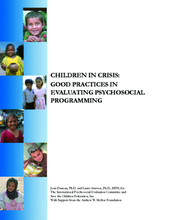In recent years, the devastating consequences of long term and violent conflicts across the globe have generated tremendous interest in the psychosocial effects of complex emergencies on children, families and communities. At the same time, as relief organizations have developed projects to address these critical issues, there have been relatively few resources available to these implementing agencies on how to measure the effectiveness of their work. What concepts, methods and tools might be used to evaluate psychosocial projects implemented during crisis situations? How do we know if individuals and communities are benefiting over the short and long-term from projects designed to facilitate emotional healing, social reconciliation, and community building?
The development of outcome and impact measures for psychosocial projects in crisis situations presents a continual challenge for field practitioners. The various factors influencing child development and psychosocial well-being are difficult to isolate, define, and quantify. In addition, change takes time to evidence itself, a luxury in any emergency response project. As a result, too often project practitioners must take a leap of faith that their projects are having a measurable and positive effect on the lives of children, families, and communities. Without indicators, however, practitioners are left in the position of asserting that projects are “helpful” in broad and often unverified ways. There clearly exists a need to develop models of impact, share lessons learned, promote cross-fertilization of strategies, and to build effective intervention practices based on sound measures of project outcomes and impact.
This manual attempts to articulate major principles of psychosocial project design and evaluation practices in concise, user-friendly terms. It is intended for field-based managers and coordinators of psychosocial programming, as well as for managers of emergency relief programs who may want to integrate psychosocial programming methods into more traditional relief efforts, such as food distribution, construction projects, and medical assistance. The manual also seeks to heighten critical awareness of the cultural and ethical issues associated with psychosocial work. Since psychosocial projects vary considerably in emphasis, there is much to be learned from different experiences. Hence, the intention of this manual is to stimulate dialogue and the exchange of “lessons learned” across projects, organizations, theoretical perspectives, and field-based experiences. Through this dialogue, we hope to help project managers build concepts and methods for planning, implementing, and evaluating psychosocial projects using clear strategies.
©Save the Children Federation

